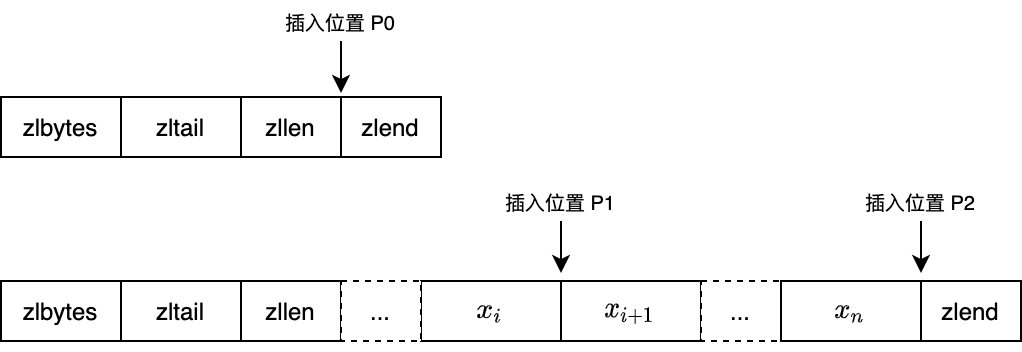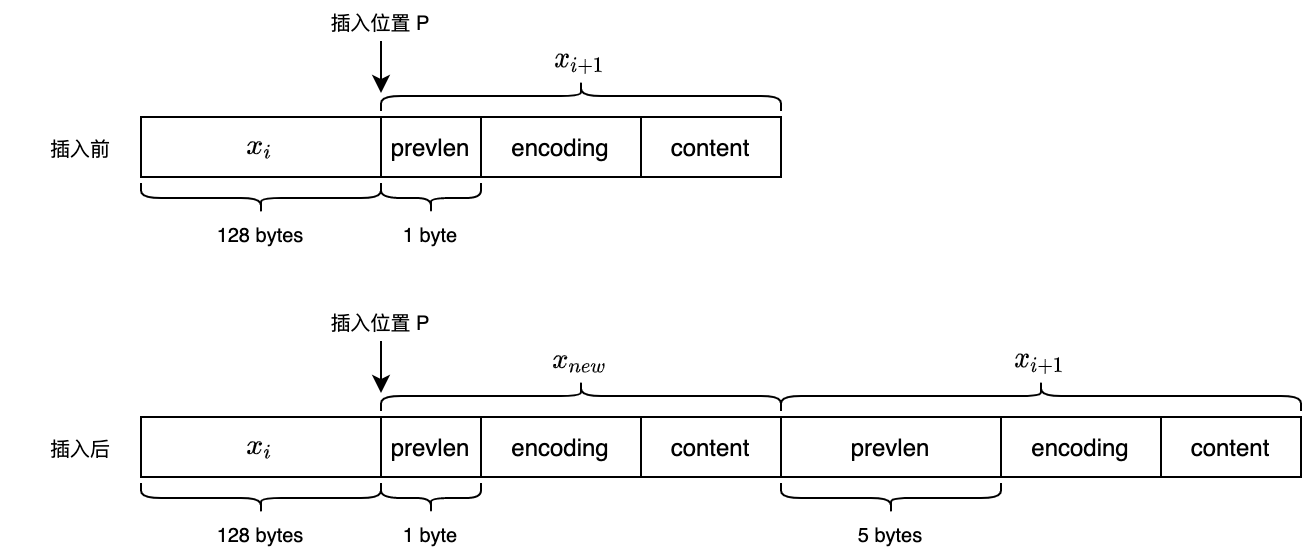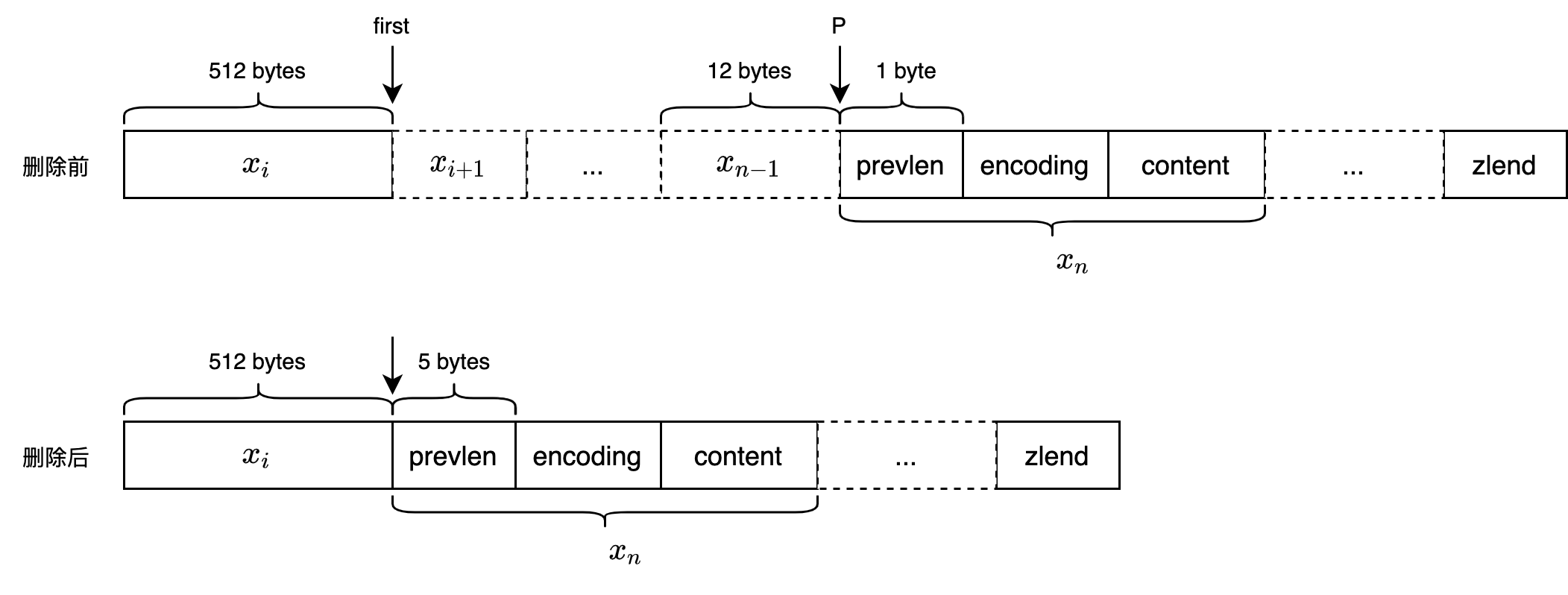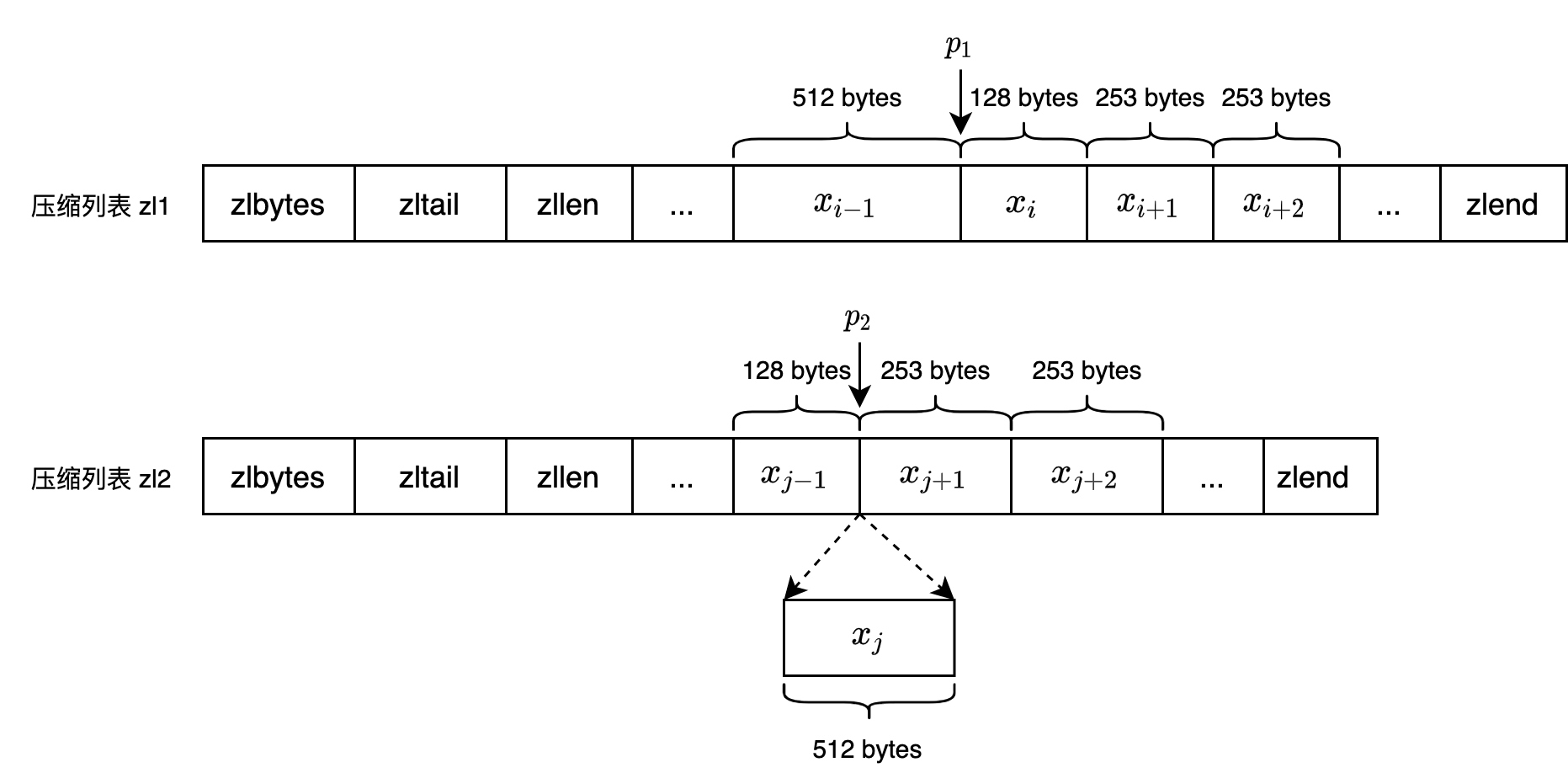压缩列表 ZipList
压缩列表「ZipList」是一个经过特殊编码的双向链表,它的设计目标就是为了提高存储效率。
压缩列表可用于存储字符串或整数,其中整数是按真正的二进制表示进行编码的,而不是编码成字符串序列,它能以 的时间复杂度在表的两端提供 push 和 pop 操作。
# 一、数据结构
# 1.1 压缩列表
Redis 使用字节数组表示一个压缩列表,压缩列表结构示意图如下所示。
![]()
各字段的含义如下:
- zlbytes:压缩列表的字节长度,占 4 个字节,因此压缩列表最多有 个字节;
- zltail:压缩列表尾元素相对于压缩列表起始地址的偏移量,占 4 个字节;
- zllen:压缩列表的元素个数,占 2 个字节;
- entry:压缩列表存储的元素,可以是字节数组或者整数,长度不限,entry 的编码结构在后面详细介绍;
- zlend:压缩列表的结尾,占 1 个字节,恒为 0xFF。
注意
zllen 无法存储元素个数超过 的压缩列表,必须遍历整个压缩列表才能获取到元素个数。
假设 char* zl 指向压缩列表首地址,Redis 可通过以下宏定义实现压缩列表各个字段的存取操作。
/* Return total bytes a ziplist is composed of. */
// zl 指向 zlbytes 字段
#define ZIPLIST_BYTES(zl) (*((uint32_t*)(zl)))
/* Return the offset of the last item inside the ziplist. */
// zl+4 指向 zltail 字段
#define ZIPLIST_TAIL_OFFSET(zl) (*((uint32_t*)((zl)+sizeof(uint32_t))))
/* Return the length of a ziplist, or UINT16_MAX if the length cannot be
* determined without scanning the whole ziplist. */
// zl+8 指向 zllen 字段,返回最大值 UINT16_MAX 时,需遍历获取长度
#define ZIPLIST_LENGTH(zl) (*((uint16_t*)((zl)+sizeof(uint32_t)*2)))
/* The size of a ziplist header: two 32 bit integers for the total
* bytes count and last item offset. One 16 bit integer for the number
* of items field. */
// 返回 ziplist 表头大小
#define ZIPLIST_HEADER_SIZE (sizeof(uint32_t)*2+sizeof(uint16_t))
/* Size of the "end of ziplist" entry. Just one byte. */
// 返回 ziplist 表尾大小
#define ZIPLIST_END_SIZE (sizeof(uint8_t))
/* Return the pointer to the first entry of a ziplist. */
// 指向第一个节点起始位置
#define ZIPLIST_ENTRY_HEAD(zl) ((zl)+ZIPLIST_HEADER_SIZE)
/* Return the pointer to the last entry of a ziplist, using the
* last entry offset inside the ziplist header. */
// 指向尾元素首地址,intrev32ifbe 使得数据存取统一采用小端法
#define ZIPLIST_ENTRY_TAIL(zl) ((zl)+intrev32ifbe(ZIPLIST_TAIL_OFFSET(zl)))
/* Return the pointer to the last byte of a ziplist, which is, the
* end of ziplist FF entry. */
// 压缩列表最后一个字节,即为 zlend 字段
#define ZIPLIST_ENTRY_END(zl) ((zl)+intrev32ifbe(ZIPLIST_BYTES(zl))-1)
2
3
4
5
6
7
8
9
10
11
12
13
14
15
16
17
18
19
20
21
22
23
24
25
26
27
28
29
30
31
32
33
34
35
36
# 1.2 压缩列表节点
上一节介绍了压缩列表的基本结构,我们可以很容易地获得压缩列表的字节长度、元素个数等。
但还有一些重要操作需要借助压缩列表元素 entry 的特殊结构才能实现,如压缩列表的遍历、获取任意存储元素的类型、获取字节数组的长度等,下面来对压缩列表元素的结构详细介绍,其编码结构示意图如下所示:

prevlen 字段
prevlen 字段表示前一个元素的字节长度,占 1 个或 5 个字节,具体规则如下:
- 前置节点长度小于 254 字节,占用 1 个字节记录该长度值;
- 前置节点长度超过 254 字节,占用 5 个字节记录该长度值;
- 第 1 个字节的值将被设为 254 ,用于标识这是一个 5 字节长的长度值;
- 之后的 4 个字节则用于保存前置节点的实际长度。
说明:由于 255 被 zlend 占用,用于标识压缩列表结尾,因此这里用 254 来标识。
encoding 字段
encoding 字段表示当前元素的编码,即 entry-data 字段存储的数据类型(字节数组或整数),数据内容存储在 entry-data 字段。为了节约内存,encoding 字段同样长度可变,具体编码形式如下所示:
| 编码 | 编码长度 | entry-data 属性保存的值 |
|---|---|---|
| xxxxxx | 1 字节 | 最大长度为 的字节数组 |
| xxxxxx xxxxxxxx | 2 字节 | 最大长度为 的字节数组 |
| xxxxxxxx xxxxxxxx xxxxxxxx xxxxxxxx | 5 字节 | 最大长度为 的字节数组 |
| 1 字节 | int16_t 类型整数 | |
| 1 字节 | int32_t 类型整数 | |
| 1 字节 | int64_t 类型整数 | |
| 1 字节 | 24 位有符号整数 | |
| 1 字节 | 8 位有符号整数 | |
| xxxx | 1 字节 | 无 entry-data 字段;xxxx 表示 0~12 的整数 |
此处可参考以下源码注释帮助对 encoding 定义的理解。
点击查看源码注释
/*
* The encoding field of the entry depends on the content of the
* entry. When the entry is a string, the first 2 bits of the encoding first
* byte will hold the type of encoding used to store the length of the string,
* followed by the actual length of the string. When the entry is an integer
* the first 2 bits are both set to 1. The following 2 bits are used to specify
* what kind of integer will be stored after this header. An overview of the
* different types and encodings is as follows. The first byte is always enough
* to determine the kind of entry.
*
* |00pppppp| - 1 byte
* String value with length less than or equal to 63 bytes (6 bits).
* "pppppp" represents the unsigned 6 bit length.
* |01pppppp|qqqqqqqq| - 2 bytes
* String value with length less than or equal to 16383 bytes (14 bits).
* IMPORTANT: The 14 bit number is stored in big endian.
* |10000000|qqqqqqqq|rrrrrrrr|ssssssss|tttttttt| - 5 bytes
* String value with length greater than or equal to 16384 bytes.
* Only the 4 bytes following the first byte represents the length
* up to 32^2-1. The 6 lower bits of the first byte are not used and
* are set to zero.
* IMPORTANT: The 32 bit number is stored in big endian.
* |11000000| - 3 bytes
* Integer encoded as int16_t (2 bytes).
* |11010000| - 5 bytes
* Integer encoded as int32_t (4 bytes).
* |11100000| - 9 bytes
* Integer encoded as int64_t (8 bytes).
* |11110000| - 4 bytes
* Integer encoded as 24 bit signed (3 bytes).
* |11111110| - 2 bytes
* Integer encoded as 8 bit signed (1 byte).
* |1111xxxx| - (with xxxx between 0000 and 1101) immediate 4 bit integer.
* Unsigned integer from 0 to 12. The encoded value is actually from
* 1 to 13 because 0000 and 1111 can not be used, so 1 should be
* subtracted from the encoded 4 bit value to obtain the right value.
* |11111111| - End of ziplist special entry.
*
* Like for the ziplist header, all the integers are represented in little
* endian byte order, even when this code is compiled in big endian systems.
*/
2
3
4
5
6
7
8
9
10
11
12
13
14
15
16
17
18
19
20
21
22
23
24
25
26
27
28
29
30
31
32
33
34
35
36
37
38
39
40
41
可以看出,根据 encoding 字段第 1 个字节的前 2 位,可以判断 entry-data 字段存储的是整数还是字节数组。
- 当 entry-data 存储的是字节数组时,后续字节标识字节数组的实际长度;
- 当 entry-data 存储的是整数时,可根据第 3、4 位判断整数的具体类型;
- 当 encoding 字段标识当前元素存储的是 0~12 的立即数时,数据直接存储在 encoding 字段的最后 4 位,此时没有 entry-data 字段。
注意
为什么是 0~12 ?
xxxx 的值只能在 和 之间,即从 1 到 13 一共 13 个值,否则会与其他编码情况冲突,而小数值应该从 0 开始,因此这 13 个值分别表示 0 到 12,即 xxxx 的值减去 1 才是它所要表示的那个整数数据的值。
参照 encoding 字段的编码表格,Redis 预定义了以下常量对应 encoding 字段的各编码类型:
#define ZIP_STR_06B (0 << 6)
#define ZIP_STR_14B (1 << 6)
#define ZIP_STR_32B (2 << 6)
#define ZIP_INT_16B (0xc0 | 0<<4)
#define ZIP_INT_32B (0xc0 | 1<<4)
#define ZIP_INT_64B (0xc0 | 2<<4)
#define ZIP_INT_24B (0xc0 | 3<<4)
#define ZIP_INT_8B 0xfe
2
3
4
5
6
7
8
上面介绍了压缩列表的存储结构,可以看到,对于压缩列表的任意元素,获取前一个元素的长度、判断存储的数据类型、获取数据内容都需要复杂的解码运算。解码后的结果应该被缓存起来,为此定义了结构体 zlentry,用于表示解码后的压缩列表元素。
/* We use this function to receive information about a ziplist entry.
* Note that this is not how the data is actually encoded, is just what we
* get filled by a function in order to operate more easily. */
typedef struct zlentry {
// 编码 prevrawlen 所需的字节大小
unsigned int prevrawlensize; /* Bytes used to encode the previous entry len*/
// 前置节点的长度
unsigned int prevrawlen; /* Previous entry len. */
// 编码 len 所需的字节大小
unsigned int lensize; /* Bytes used to encode this entry type/len.
For example strings have a 1, 2 or 5 bytes
header. Integers always use a single byte.*/
// 当前节点的长度
unsigned int len; /* Bytes used to represent the actual entry.
For strings this is just the string length
while for integers it is 1, 2, 3, 4, 8 or
0 (for 4 bit immediate) depending on the
number range. */
// 当前节点 header 大小
unsigned int headersize; /* prevrawlensize + lensize. */
// 当前节点值所使用的编码类型
unsigned char encoding; /* Set to ZIP_STR_* or ZIP_INT_* depending on
the entry encoding. However for 4 bits
immediate integers this can assume a range
of values and must be range-checked. */
// 指向当前节点的指针
unsigned char *p; /* Pointer to the very start of the entry, that
is, this points to prev-entry-len field. */
} zlentry;
2
3
4
5
6
7
8
9
10
11
12
13
14
15
16
17
18
19
20
21
22
23
24
25
26
27
28
29
函数 zipEntry 用来解码压缩列表的元素,存储于 zlentry 结构体 e。
/* Return a struct with all information about an entry. */
void zipEntry(unsigned char *p, zlentry *e) {
ZIP_DECODE_PREVLEN(p, e->prevrawlensize, e->prevrawlen);
ZIP_DECODE_LENGTH(p + e->prevrawlensize, e->encoding, e->lensize, e->len);
e->headersize = e->prevrawlensize + e->lensize;
e->p = p;
}
2
3
4
5
6
7
8
可以看到,解码主要可以分为以下两个步骤:
- 解码 prevlen,此时入参 ptr 指向元素首地址。
点击查看代码
#define ZIP_BIG_PREVLEN 254 /* Max number of bytes of the previous entry, for
the "prevlen" field prefixing each entry, to be
represented with just a single byte. Otherwise
it is represented as FF AA BB CC DD, where
AA BB CC DD are a 4 bytes unsigned integer
representing the previous entry len. */
/* Return the number of bytes used to encode the length of the previous
* entry. The length is returned by setting the var 'prevlensize'. */
#define ZIP_DECODE_PREVLENSIZE(ptr, prevlensize) do { \
if ((ptr)[0] < ZIP_BIG_PREVLEN) { \
(prevlensize) = 1; \
} else { \
(prevlensize) = 5; \
} \
} while(0);
/* Return the length of the previous element, and the number of bytes that
* are used in order to encode the previous element length.
* 'ptr' must point to the prevlen prefix of an entry (that encodes the
* length of the previous entry in order to navigate the elements backward).
* The length of the previous entry is stored in 'prevlen', the number of
* bytes needed to encode the previous entry length are stored in
* 'prevlensize'. */
#define ZIP_DECODE_PREVLEN(ptr, prevlensize, prevlen) do { \
ZIP_DECODE_PREVLENSIZE(ptr, prevlensize); \
if ((prevlensize) == 1) { \
(prevlen) = (ptr)[0]; \
} else if ((prevlensize) == 5) { \
assert(sizeof((prevlen)) == 4); \
memcpy(&(prevlen), ((char*)(ptr)) + 1, 4); \
memrev32ifbe(&prevlen); \
} \
} while(0);
2
3
4
5
6
7
8
9
10
11
12
13
14
15
16
17
18
19
20
21
22
23
24
25
26
27
28
29
30
31
32
33
34
- 解码 encoding 字段,此时入参 ptr 指向元素首地址偏移 prevlen 长度的位置。
点击查看代码
#define ZIP_STR_MASK 0xc0
/* Extract the encoding from the byte pointed by 'ptr' and set it into
* 'encoding' field of the zlentry structure. */
#define ZIP_ENTRY_ENCODING(ptr, encoding) do { \
(encoding) = (ptr[0]); \
if ((encoding) < ZIP_STR_MASK) (encoding) &= ZIP_STR_MASK; \
} while(0)
/* Return bytes needed to store integer encoded by 'encoding'. */
unsigned int zipIntSize(unsigned char encoding) {
switch(encoding) {
case ZIP_INT_8B: return 1;
case ZIP_INT_16B: return 2;
case ZIP_INT_24B: return 3;
case ZIP_INT_32B: return 4;
case ZIP_INT_64B: return 8;
}
if (encoding >= ZIP_INT_IMM_MIN && encoding <= ZIP_INT_IMM_MAX)
return 0; /* 4 bit immediate */
panic("Invalid integer encoding 0x%02X", encoding);
return 0;
}
/* Decode the entry encoding type and data length (string length for strings,
* number of bytes used for the integer for integer entries) encoded in 'ptr'.
* The 'encoding' variable will hold the entry encoding, the 'lensize'
* variable will hold the number of bytes required to encode the entry
* length, and the 'len' variable will hold the entry length. */
#define ZIP_DECODE_LENGTH(ptr, encoding, lensize, len) do { \
ZIP_ENTRY_ENCODING((ptr), (encoding)); \
if ((encoding) < ZIP_STR_MASK) { \
if ((encoding) == ZIP_STR_06B) { \
(lensize) = 1; \
(len) = (ptr)[0] & 0x3f; \
} else if ((encoding) == ZIP_STR_14B) { \
(lensize) = 2; \
(len) = (((ptr)[0] & 0x3f) << 8) | (ptr)[1]; \
} else if ((encoding) == ZIP_STR_32B) { \
(lensize) = 5; \
(len) = ((ptr)[1] << 24) | \
((ptr)[2] << 16) | \
((ptr)[3] << 8) | \
((ptr)[4]); \
} else { \
panic("Invalid string encoding 0x%02X", (encoding)); \
} \
} else { \
(lensize) = 1; \
(len) = zipIntSize(encoding); \
} \
} while(0);
2
3
4
5
6
7
8
9
10
11
12
13
14
15
16
17
18
19
20
21
22
23
24
25
26
27
28
29
30
31
32
33
34
35
36
37
38
39
40
41
42
43
44
45
46
47
48
49
50
51
52
# 二、基本操作
# 2.1 创建压缩列表
创建空的压缩列表,只需要分配初始存储空间 ZIPLIST_HEADER_SIZE+1 个字节,并对 zlbytes、zltail、zllen 和 zlend 字段初始化即可。
/* Create a new empty ziplist. */
unsigned char *ziplistNew(void) {
// ZIPLIST_HEADER_SIZE 是 ziplist 表头的大小
// 1 字节是表末端 zlend 的大小
unsigned int bytes = ZIPLIST_HEADER_SIZE+1;
// 为表头和表末端分配空间
unsigned char *zl = zmalloc(bytes);
// 初始化表属性
ZIPLIST_BYTES(zl) = intrev32ifbe(bytes);
ZIPLIST_TAIL_OFFSET(zl) = intrev32ifbe(ZIPLIST_HEADER_SIZE);
ZIPLIST_LENGTH(zl) = 0;
// 设置表末端
zl[bytes-1] = ZIP_END;
return zl;
}
2
3
4
5
6
7
8
9
10
11
12
13
14
15
16
17
18
19
20
# 2.2 插入元素
压缩列表插入元素的 API 定义如下,函数输入参数 zl 表示压缩列表首地址,p 指向元素插入位置,s 表示数据内容,slen 表示数据长度,返回值为压缩列表首地址。
/**
* 将包含给定值 s 的新节点插入到给定的位置 p 中;
*/
unsigned char *ziplistInsert(unsigned char *zl, unsigned char *p,
unsigned char *s, unsigned int slen) {
return __ziplistInsert(zl,p,s,slen);
}
2
3
4
5
6
7
插入元素可以简要分为 3 个步骤:编码、重新分配空间、数据复制,下面分别讲解每个步骤的实现逻辑。
1. 编码
编码即计算 prevlen、encoding 和 entry-data 的内容。
其中 prevlen 的计算需要根据插入位置分情况讨论,插入位置示意图如下所示:

- 当压缩列表为空、插入位置为 时,不存在前一个元素,即前一个元素的长度为 0;
- 当插入位置为 时,需要获取 元素的长度,而 元素的 prevlen 字段存储的就是 元素的长度,很容易获取到;
- 当插入位置为 时,需要获取 元素的长度, 是压缩列表的尾元素,计算元素长度时需要将其 3个字段长度相加,函数实现如下。
/* Return the total number of bytes used by the entry pointed to by 'p'. */
unsigned int zipRawEntryLength(unsigned char *p) {
unsigned int prevlensize, encoding, lensize, len;
ZIP_DECODE_PREVLENSIZE(p, prevlensize);
ZIP_DECODE_LENGTH(p + prevlensize, encoding, lensize, len);
return prevlensize + lensize + len;
}
2
3
4
5
6
7
encoding 字段标识的是当前元素存储的数据类型和数据长度。编码时首先尝试将数据内容解析为整数,如果解析成功,则按照压缩列表整数类型编码存储;如果解析失败,则按照压缩列表字节数组类型编码存储。
/* See if the entry can be encoded */
if (zipTryEncoding(s,slen,&value,&encoding)) {
/* 'encoding' is set to the appropriate integer encoding */
reqlen = zipIntSize(encoding);
} else {
/* 'encoding' is untouched, however zipStoreEntryEncoding will use the
* string length to figure out how to encode it. */
reqlen = slen;
}
/* We need space for both the length of the previous entry and
* the length of the payload. */
reqlen += zipStorePrevEntryLength(NULL,prevlen);
reqlen += zipStoreEntryEncoding(NULL,encoding,slen);
2
3
4
5
6
7
8
9
10
11
12
13
上述程序尝试按照整数解析新添加元素的数据内容,数值存储在变量 value 中,编码存储在变量 encoding 中。如果解析成功,还需要计算整数所占字节数。
变量 reqlen 最终存储的是当前元素所需空间大小,初始赋值为元素 content 字段所需空间大小,再累加 prevlen 和 encoding 字段所需空间大小。
2. 重新分配空间
由于新插入了元素,压缩列表所需空间增大,因此需要重新分配存储空间,一种压缩列表长度变化情况如下所示:

插入元素前, 元素的长度为 128 字节, 元素的 prevlen 字段占 1 个字节;添加元素 ,元素长度为 1024 字节,此时 元素的 prevlen 字段需要占 5 个字节,即压缩列表的长度不仅增加了 1024 个字节,还要加上 元素扩展的 4 个字节。
由于重新分配了空间,新元素插入的位置指针 P 会失效,可以预先计算好指针 P 相对于压缩列表首地址的偏移量,待分配空间之后再偏移即可。
3. 数据复制
重新分配空间之后,需要将位置 P 后的元素移动到指定位置,将新元素插入到位置 P。
# 2.3 删除元素
压缩列表删除元素的 API 定义如下,函数输入参数 zl 指向压缩列表首地址,*p 指向待删除元素的首地址(参数 p 同时可以作为输出参数),返回参数为压缩列表首地址。
/* Delete a single entry from the ziplist, pointed to by *p.
* Also update *p in place, to be able to iterate over the
* ziplist, while deleting entries. */
unsigned char *ziplistDelete(unsigned char *zl, unsigned char **p) {
size_t offset = *p-zl;
zl = __ziplistDelete(zl,*p,1);
/* Store pointer to current element in p, because ziplistDelete will
* do a realloc which might result in a different "zl"-pointer.
* When the delete direction is back to front, we might delete the last
* entry and end up with "p" pointing to ZIP_END, so check this. */
*p = zl+offset;
return zl;
}
2
3
4
5
6
7
8
9
10
11
12
13
14
删除元素同样可以简要分为 3 个步骤:计算待删除元素的总长度、数据复制、重新分配空间,下面分别讲解每个步骤的实现逻辑。
1. 计算待删除元素的总长度
// 解码第一个待删除元素
zipEntry(p, &first);
// 遍历所有待删除元素,同时指针 p 向后偏移
for (i = 0; p[0] != ZIP_END && i < num; i++) {
p += zipRawEntryLength(p);
deleted++;
}
// totlen 即为待删除元素总长度
totlen = p-first.p; /* Bytes taken by the element(s) to delete. */
2
3
4
5
6
7
8
9
10
11
2. 数据复制
第 1 步完成之后,指针 first 与指针 p 之间的元素都是待删除的。当指针 p 恰好指向 zlend 字段时,不再需要复制数据,只需要更新尾节点的偏移量即可。
下面分析另一种情况,即指针 p 指向的是某一个元素,而不是 zlend 字段,一种压缩列表长度变化情况如下所示:

删除元素 到元素 之间的 n-x-1 个元素,元素 的长度为 12 字节,因此 的 prevlen 字段占 1 字节;删除这些元素之后, 成为 的前一个元素,元素 的长度为 512 字节,因此 的 prevlen 字段需要占 5 个字节,即删除元素之后的压缩列表总长度还与元素 的长度变化量有关。
3. 重新分配空间
与插入元素类似,这里不再赘述。
# 2.4 遍历压缩列表
压缩列表的遍历 API 定义如下,函数输入参数 zl 指向压缩列表首地址,p 指向当前访问元素的首地址;ziplistNext 函数返回后一个元素的首地址,ziplistPrev 返回前一个元素的首地址。
// 后向遍历
unsigned char *ziplistNext(unsigned char *zl, unsigned char *p);
// 前向遍历
unsigned char *ziplistPrev(unsigned char *zl, unsigned char *p);
2
3
4
5
压缩列表每个元素的 prevlen 字段存储的是前一个元素的长度,因此压缩列表的前向遍历相对简单,表达式 p-prevlen 即可获取前一个元素的首地址,这里不做详述。
后向遍历时,需要解码当前元素,计算当前元素的长度,才能获取后一个元素首地址,ziplistNext 函数实现如下:
/* Return pointer to next entry in ziplist.
*
* zl is the pointer to the ziplist
* p is the pointer to the current element
*
* The element after 'p' is returned, otherwise NULL if we are at the end. */
unsigned char *ziplistNext(unsigned char *zl, unsigned char *p) {
((void) zl);
/* "p" could be equal to ZIP_END, caused by ziplistDelete,
* and we should return NULL. Otherwise, we should return NULL
* when the *next* element is ZIP_END (there is no next entry). */
if (p[0] == ZIP_END) {
return NULL;
}
p += zipRawEntryLength(p);
if (p[0] == ZIP_END) {
return NULL;
}
return p;
}
2
3
4
5
6
7
8
9
10
11
12
13
14
15
16
17
18
19
20
21
22
23
# 三、连锁更新
压缩列表连锁更新示意如下所示,当删除压缩列表 zl1 位置 的元素 ,或者在压缩列表 zl2 位置 插入元素 时,会导致连锁更新。

压缩列表 zl1 中,元素 之后的元素 、 的长度都是 253 字节,因此这些元素的 prevlen 字段长度都是 1 字节。
当删除元素 时,元素 的前驱节点改为元素 ,长度为 512 字节,元素 的 prevlen 字段需要 5 字节才能存储元素 的长度,则元素 的长度需要扩展至 257 字节;而由于元素 长度的增大,元素 的 prevlen 字段同样需要改变。
依此类推,由于删除了元素 ,之后的元素 、 的长度都必须扩展,而每次扩展都将重新分配内存,导致效率很低。
压缩列表 zl2 中,插入元素 时同样会出现这种情况,称为连锁更新。
注意
连锁更新造成性能问题的几率是很低的。
- 首先,压缩列表里要恰好有多个连续的、长度介于 250 字节至 253 字节之间的节点,连锁更新才可能触发,在实际中,这种情况并不多见;
- 其次,即使出现连锁更新,但只要被更新的节点不多,就不会对性能造成任何影响。
# 四、总结
- 压缩列表是一种为节约内存而开发的顺序型数据结构;
- 压缩列表可以包含多个节点,每个节点可以保存一个字节数组或整数值;
- 添加或删除节点到压缩列表,可能导致连锁更新,但这种操作出现几率并不高。
# 五、参考资料
- 《Redis 5 设计与源码分析》– 陈雷
- 《Redis 设计与实现》– 黄健宏
- Redis内部数据结构详解(4) – ziplist (opens new window)
